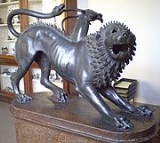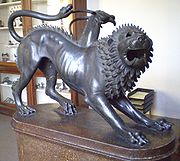
Tinia
Encyclopedia

Sky
The sky is the part of the atmosphere or outer space visible from the surface of any astronomical object. It is difficult to define precisely for several reasons. During daylight, the sky of Earth has the appearance of a pale blue surface because the air scatters the sunlight. The sky is sometimes...
and the highest god in Etruscan mythology
Etruscan mythology
The Etruscans were a diachronically continuous population, with a distinct language and culture during the period of earliest European writing, in the Mediterranean Iron Age in the second half of the first millennium BC...
, equivalent to the Roman
Roman mythology
Roman mythology is the body of traditional stories pertaining to ancient Rome's legendary origins and religious system, as represented in the literature and visual arts of the Romans...
Jupiter and the Greek
Greek mythology
Greek mythology is the body of myths and legends belonging to the ancient Greeks, concerning their gods and heroes, the nature of the world, and the origins and significance of their own cult and ritual practices. They were a part of religion in ancient Greece...
Zeus
Zeus
In the ancient Greek religion, Zeus was the "Father of Gods and men" who ruled the Olympians of Mount Olympus as a father ruled the family. He was the god of sky and thunder in Greek mythology. His Roman counterpart is Jupiter and his Etruscan counterpart is Tinia.Zeus was the child of Cronus...
. He was the husband of Thalna
Thalna
In Etruscan mythology, Thalna was the goddess of childbirth and wife of Tinia. She was depicted in art as a youthful woman.Early Roman Mythology focused on the interlocking and complex interrelations between gods and humans. In this, the Romans maintained a large selection of divinities with...
or Uni
Uni (mythology)
Uni was the supreme goddess of the Etruscan pantheon and the patron goddess of Perugia. Uni was identified by the Etruscans as their equivalent of Juno in Roman mythology and Hera in Greek mythology....
and the father of Heracle
Heracle
Heracle in Etruscan mythology was the equivalent of the Greek hero Heracles from which he derives.In the Etruscan tradition, Uni grants Hercle access to a life among the immortals by offering her breast milk to him....
.
He was part of the powerful triad that included Menrva
Menrva
Menrva was an Etruscan goddess of war, art, wisdom and health. She contributed much of her character to Roman Minerva....
and Uni. He was associated with lightning, spears and scepters. In the Etruscan language
Etruscan language
The Etruscan language was spoken and written by the Etruscan civilization, in what is present-day Italy, in the ancient region of Etruria and in parts of Lombardy, Veneto, and Emilia-Romagna...
, tin or tinš means "day" and its plural is tinia showing that he is a god governing the passage of time
Time
Time is a part of the measuring system used to sequence events, to compare the durations of events and the intervals between them, and to quantify rates of change such as the motions of objects....
(compare Father Time
Father Time
Father Time is usually depicted as an elderly bearded man, somewhat worse for wear, dressed in a robe, carrying a scythe and an hourglass or other timekeeping device...
and Ancient of Days
Ancient of Days
Ancient of Days is a name for God in Aramaic: Atik Yomin; in the Greek Septuagint: Palaios Hemeron; and in the Vulgate: Antiquus Dierum....
).
Some of Tinia's defining epithet
Epithet
An epithet or byname is a descriptive term accompanying or occurring in place of a name and having entered common usage. It has various shades of meaning when applied to seemingly real or fictitious people, divinities, objects, and binomial nomenclature. It is also a descriptive title...
s are detailed on the Piacenza Liver
Haruspex
In Roman and Etruscan religious practice, a haruspex was a man trained to practice a form of divination called haruspicy, hepatoscopy or hepatomancy. Haruspicy is the inspection of the entrails of sacrificed animals, especially the livers of sacrificed sheep and poultry...
, a bronze model of a liver used for haruspicy. Some of his epithets inscribed there include Tin Cilens, Tin Θuf and Tinś Θne.
Some inscriptions in which he appears are as follows.
- On a kylix painted by OltosOltosOltos was a Late Archaic Greek vase painter, active in Athens. From the time between 525 BC and 500 BC, about 150 works by him are known. Two pieces, a cup in Berlin and a cup in Tarquinia , are signed by him as painter.Oltos is thought to have begun his career in the workshop of the potter...
(ca 500 BC):
- Itun turuce venel atelinas Tinas cliniiaras.
- This has given Venel Atelinas for the sons of Tin (ie: The Dioscuri).
- On the bronze Chimera of ArezzoChimera of ArezzoThe bronze "Chimera of Arezzo" is one of the best known examples of the art of the Etruscans. It was found in Arezzo, an ancient Etruscan and Roman city in Tuscany, in 1553 and was quickly claimed for the collection of the Medici Grand Duke of Tuscany Cosimo I, who placed it publicly in the...
:
- Tinscvil
- A gift to Tinia

